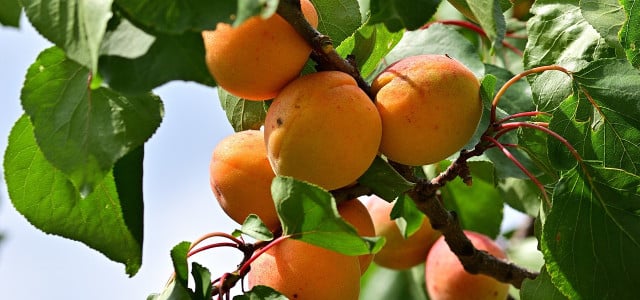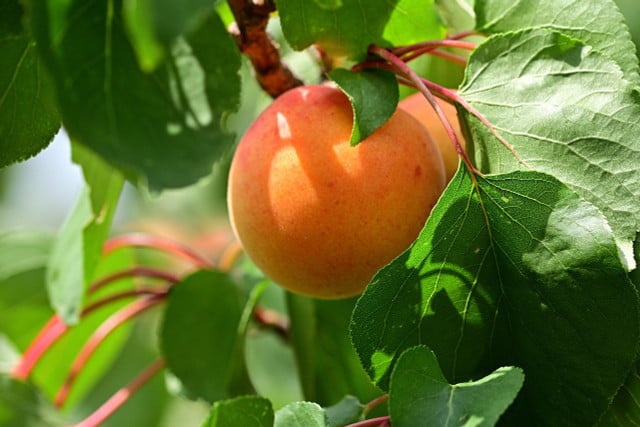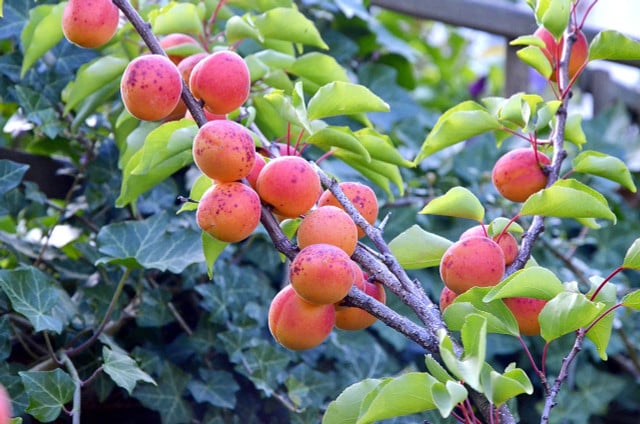
The apricot tree is rarely found in European gardens. Find out here how you can also cultivate the fruit tree in this country and how to care for and prune it properly.
The apricot tree originally comes from Asia. Similar to the peach tree, it only grows well in warmer areas with a dry climate. That’s why you rarely find it in native natural gardens, but rather in vineyard areas with mild weather. However, in the right location and with proper care, you can grow the apricot tree in cooler areas as well.
Contents
Planting an apricot tree in a bed

Before you plant an apricot tree in your garden, you should ask at the garden center for particularly robust varieties. Also ask whether the fruit tree you have chosen is accustomed to the conditions in your region. Apricot trees can be purchased as balled or containerized plants. Before you put the tree in the ground, you should consider the following:
The right time: it is best to plant the apricot tree in October or November. This will give the tree enough time to develop its roots over the winter.
The right location: The apricot tree thrives best in a sunny, warm and wind-protected place. Even full sun does not bother the fruit tree. In colder climates, you can also plant the apricot tree as an espalier fruit on a south-facing house wall, where it is better protected from frost.
The right soil: Light sandy, well-drained soil with a high humus content is ideal for the apricot tree. Important: The soil should not be too wet.
Plant the apricot tree in the bed:
- First, dig the planting hole. You should dig it one third deeper than the height of the root ball and about twice as wide.
- Loosen the soil at the bottom of the hole with a hoe and lay a thin layer of pebbles. This so-called “drainage layer” ensures that the irrigation water runs off better and does not accumulate.
- Now insert a support stake into the loosened soil. It should be about the same height as the trunk of the apricot tree.
- Mix the excavated planting soil with plenty of compost and horn shavings.
- Place the apricot tree in the planting hole so that the grafting point on the lower trunk is still about five inches above the soil surface.
- Fill the hole again with the soil mixture and tamp the soil down lightly. Don’t forget to water the tree generously at the end.
Planting apricot tree in a container

If your region has a somewhat harsher and cooler climate, you can also plant the apricot tree in a container. The best trees for this purpose are those that grow in a columnar form and reach a maximum height of 220 centimeters. Proceed as follows when planting:
- Find a plant pot with a capacity of about 30 liters and a hole in the middle. This will prevent waterlogging later on.
- Lay a thin drainage layer of gravel or clay shards at the bottom of the pot.
- Now mix some garden soil with compost and horn shavings in a separate container.
- Spread a layer of the soil-compost mixture over the drainage layer.
- Place the small tree in the container.
- Gradually fill the bucket with the rest of the soil mixture, pressing it down gently as you go.
- In addition, you can place another support stake in the soil.
- Finally, water the apricot tree generously with rainwater.
Proper care for the apricot tree

In order for your young apricot tree to develop well, you need to care for it properly. With the following tips, you will ensure a bountiful apricot harvest this summer:
- Watering: Apricot trees do not tolerate excessively moist soil and waterlogging well. Therefore, you should only water adult trees during long dry periods. The soil of young apricot trees, on the other hand, should be kept slightly moist. Water them only when the top layer of soil has dried slightly. Preferably use rainwater or decalcified tap water. Use a thin mulch layer of autumn leaves or bark mulch to prevent the soil from drying out too quickly.
- Fertilize: From March to July, you should fertilize the apricot tree once a month to help it grow. Use mainly organic fertilizer and compost, which you lift under the ground.
- Wintering: The apricot tree itself is hardy, but it will appreciate some support during the cold season. You can protect the root zone from frost with straw or autumn leaves. The intense winter sun in combination with the frosty temperatures can cause cracks to form in the bark of the tree. You can prevent this by leaning a few wooden slats against the trunk at an angle for protection. Apricot trees in tubs can simply be placed in a frost-free, bright location over the winter.
- Diseases and pests: If the spring is very wet, the apricot tree can be affected by monilia tip drought. Shotgun disease and curl disease are also a threat. You can avoid most diseases by placing the tree in a suitable location and watering regularly with strengthening nettle manure.
Prune apricot tree: How to do it right

After the harvest is the best time to prune the apricot tree.
Like most fruit trees, you should prune the apricot tree so that it gets enough air and sun. The best time is after the harvest in the fall. This is how you do it:
First remove the competing shoots to the central leading shoot. This is especially important in the first and second year after planting, so that the apricot tree gets the right shape. Always cut just above an outward facing bud.
Remove dead and dead branches to thin out the crown.
Cut off inward-growing and vertically upward-facing shoots.
Tip: Always cut branches at a slight angle and use only sharp pruning shears. This will prevent unnecessary bruising of the intersections.









